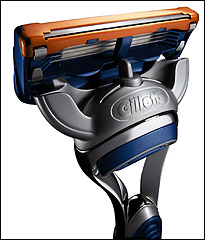Mar 27, 2006Television viewers got their first look at Gillette's new Fusion razor in a science fiction-inspired commercial that aired during this year's Super Bowl game. At about the same time, Procter & Gamble's EPC team in Boston got its first virtual look at Fusion razors being brought out to the shelves of 400 retail locations thousands of miles away. But it was RFID, not science fiction, that provided this visibility.
The technology enabled Gillette to get the product on store shelves 11 days faster than its normal turn-around time for product launches, which translates into 11 days of sales in 400 stores that the retailers and Gillette might have otherwise missed. The five-blade razor is Gillette's answer to its competitor Schick's four-blade Quattro, so it was an important launch into the razor-and-blade industry. According to Gillette, that industry totals $2.4 billion in the United States and $10 billion globally.
"Fusion is the first Gillette product that has been completely EPC-supported at the time of launch," says Paul Fox, director of global external relations for Procter & Gamble, Gillette's parent company. This means Gillette placed RFID smart labels on all cases and pallets of the razors shipped to the 400 RFID-enabled retail locations of its two customers involved in the pilot, which Fox declines to name.
Gillette also placed tags on the Fusion promotional displays it sent the retailers. "Because the [cases of] Fusion product were EPC-enabled, it got onto the shelves in three days [of being sent from Gillette's distribution center]. This process typically takes 14 days for a new product launch."
Fox attributes the swiftness of the Fusion launch to the added visibility the tagged goods provided the company. This visibility began as the goods arrived at the retailers' distribution centers and ended, most importantly, at the retailers' box-crushing machines, where reads of the Fusion case tags allowed Gillette to infer that all contents had been placed on shelves. In cases where the retailer's EPC feedback network showed the Fusion razors or promotional displays had reached a retail store's back room, but no read events were recorded showing the goods being brought to the sales floor in a timely manner, Gillette contacted the managers of those stores and requested the razors and displays be brought out.
Gillette forecasts a 25 percent return on its RFID investment over the next 10 years, through increased sales and productivity savings. The company's success at getting the Fusion razors onto shelves more than 90 percent faster than normal indicates the significant impact RFID can make as an enabler of more efficient supply chain operations.
Gillette's decision to tag and track the Fusion product concurrent with the launch is part of P&G's EPC Advanced Strategy, which the company developed to provide product-by-product guidelines for rolling out EPC tagging. The strategy divides products into three categories: RF-friendly products presenting a clear business case for RFID tracking; products on which tags are not easy to read, or those that might not offer a compelling business case; and products on which RFID tags are very difficult to read, along with those not offering a compelling business case for tagging (see P&G Adopts EPC Advantaged Strategy).
Another part of the EPC Advanced Strategy involves testing the latest RFID technology so the company can identify the hardware and software applications that might help it and its supply chain partners reap as much supply chain visibility and efficiency as possible from its EPC systems. To that end, P&G is testing Vue Technology's TrueVUE RFID Platform in a simulated end-to-end product visibility supply-chain solution at P&G's demonstration center.
The Vue platform includes technology linking large arrays of antennas, which can be built into shelves holding tagged products, to small networks of interrogators (readers). The interrogators are linked to Vue's networking device, which runs TrueVue, Vue's middleware platform. TrueVue commissions EPCs for item, case and pallet tags, filters and aggregates tag reads and associates the tag data with the order and shipping data. The supply chain simulation shows how tagged goods can be traced from the point of manufacture, through distribution channels and to store shelves, says Vue's senior vice president of product management and business, Tim von Kaenel. P&G, von Kaenel notes, has been sharing the supply chain demonstration with partners and customers.


